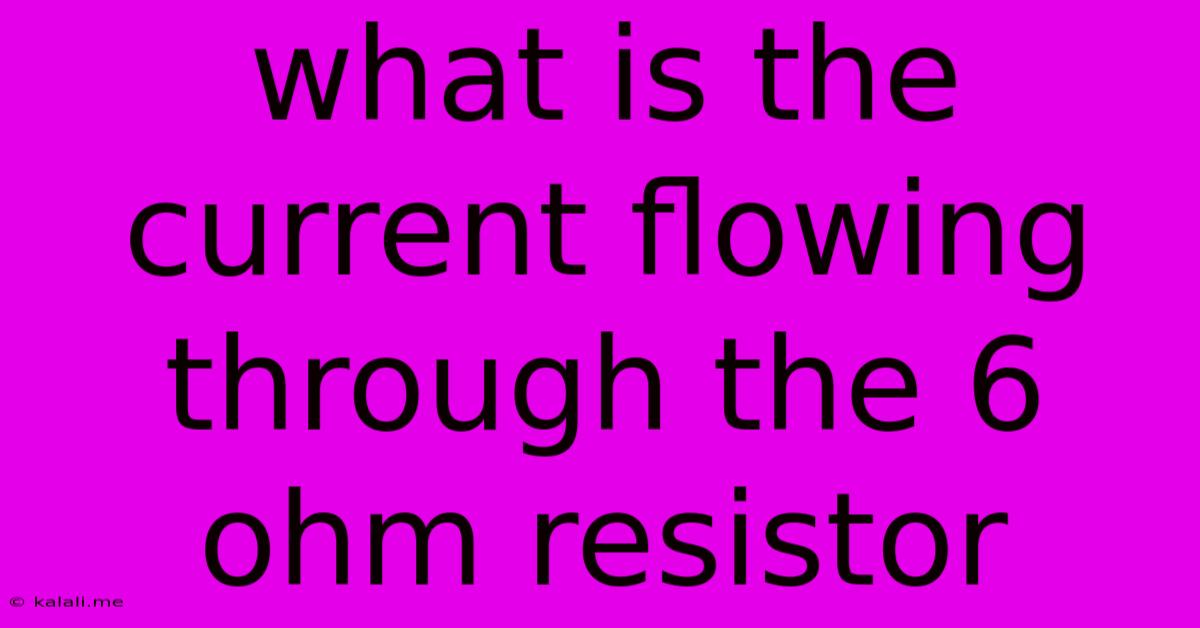What Is The Current Flowing Through The 6 Ohm Resistor
Kalali
Jun 15, 2025 · 3 min read

Table of Contents
What is the Current Flowing Through the 6 Ohm Resistor? A Comprehensive Guide
This article will guide you through calculating the current flowing through a 6-ohm resistor within a circuit. Understanding this requires a fundamental grasp of Ohm's Law and circuit analysis techniques. We'll explore various scenarios, from simple series circuits to more complex parallel configurations. This will equip you with the knowledge to tackle similar problems effectively.
Understanding Ohm's Law: The Foundation of Circuit Analysis
Before diving into specific examples, let's refresh our understanding of Ohm's Law, the cornerstone of electrical circuit analysis. Ohm's Law states:
V = I * R
Where:
- V represents the voltage across the resistor (measured in Volts).
- I represents the current flowing through the resistor (measured in Amperes).
- R represents the resistance of the resistor (measured in Ohms).
This simple equation allows us to calculate any of the three variables (V, I, or R) if we know the other two. We'll use this law extensively in the examples below.
Scenario 1: Simple Series Circuit
Imagine a simple series circuit consisting of a 12-volt battery and a single 6-ohm resistor. Using Ohm's Law, we can easily calculate the current:
I = V / R = 12V / 6Ω = 2A
Therefore, the current flowing through the 6-ohm resistor in this simple series circuit is 2 Amperes.
Scenario 2: Series Circuit with Multiple Resistors
Let's consider a more complex scenario: a series circuit with a 12-volt battery, a 6-ohm resistor, and a 4-ohm resistor. To find the current through the 6-ohm resistor, we must first calculate the total resistance:
R<sub>total</sub> = R<sub>1</sub> + R<sub>2</sub> = 6Ω + 4Ω = 10Ω
Now, we can use Ohm's Law to find the total current in the circuit:
I<sub>total</sub> = V / R<sub>total</sub> = 12V / 10Ω = 1.2A
Since this is a series circuit, the current is the same throughout the entire circuit. Therefore, the current flowing through the 6-ohm resistor is also 1.2 Amperes.
Scenario 3: Parallel Circuit
Parallel circuits present a different challenge. Consider a 12-volt battery connected to a 6-ohm resistor and a 3-ohm resistor in parallel. The voltage across each resistor in a parallel circuit is the same (12V in this case).
Let's calculate the current through the 6-ohm resistor:
I<sub>6Ω</sub> = V / R<sub>6Ω</sub> = 12V / 6Ω = 2A
The current flowing through the 6-ohm resistor in this parallel circuit is 2 Amperes. Note that the total current drawn from the battery would be higher, as it's the sum of the currents through each branch.
Kirchhoff's Current Law (KCL)
For more complex circuits involving multiple branches and junctions, Kirchhoff's Current Law (KCL) becomes essential. KCL states that the sum of currents entering a junction equals the sum of currents leaving that junction. This law, in conjunction with Ohm's Law, allows for the systematic solution of even the most intricate circuits.
Conclusion
Calculating the current flowing through a specific resistor depends heavily on the circuit's configuration. Understanding Ohm's Law, series and parallel circuit analysis, and Kirchhoff's Current Law are crucial skills for solving these types of problems. By systematically applying these principles, you can accurately determine the current flowing through any resistor in a given circuit, regardless of its complexity. Remember to always carefully identify the type of circuit and utilize the appropriate equations to achieve accurate results.
Latest Posts
Latest Posts
-
Difference Between Center Of Gravity And Centroid
Jun 16, 2025
-
Which Figure Has At Least One Line Of Symmetry
Jun 16, 2025
-
Which Heart Chamber Has The Thickest Muscle Wall
Jun 16, 2025
-
What Is The Factors Of 135
Jun 16, 2025
-
Match Each Threat To Internal Validity To The Appropriate Description
Jun 16, 2025
Related Post
Thank you for visiting our website which covers about What Is The Current Flowing Through The 6 Ohm Resistor . We hope the information provided has been useful to you. Feel free to contact us if you have any questions or need further assistance. See you next time and don't miss to bookmark.